Fri 23 Sep 2016
Music I’m Listening To: RARE EARTH “Wine, Women and Song.”
Posted by Steve under Music I'm Listening To[2] Comments
From this long-lived (and still active) rock band’s 1976 album, Midnight Lady:
Fri 23 Sep 2016
From this long-lived (and still active) rock band’s 1976 album, Midnight Lady:
Thu 22 Sep 2016
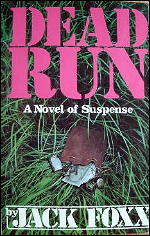
JACK FOXX – Dead Run. Bobbs Merrill, hardcover, 1975. Detective Book Club, hardcover 3-in-1 reprint edition. Carroll & Graf, hardcover, 1992, as by Bill Pronzini; paperback, August 1992. Speaking Volumes, trade paperback, 2012, also as by Bill Pronzini.
Honest work in Singapore having become scarce since his recent affair with the jade figurine, Dan Connell takes a job as overseer of a rubber plantation in Malaysia’s Selangor province, but the trip up the coast by slow steamer leads him into more trouble and adventure than even a man of Connell’s unsavory past has a right to expect.
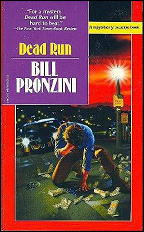
Two men are seen throwing overboard a third man, a fired bank employee who had stopped briefly in Connell‘s cabin, but quickly it becomes obvious that they were frustrated in getting from him what they wanted. There’s a girl, too, the plantation owner’s daughter, with whom Connell ends up lost in a leech-infested jungle, and a hair-raising airplane flight with a madman lovingly caressing a grenade ready to go off at any minute.
The plot ingredients are easily recognized as those of countless pulp adventure thrillers. but they are bv no means outdated, as Foxx/Pronzini capably shows. It’s reassuring to learn that there are still places in this world far enough away for the special flavor of the exotic unknown to be kept alive, capable of giving the reader that intimate thrill of escaping into another world of romantic adventure.
Indeed, this has the same immediacy as that provided by the urgent voice-over narration of a top-notch radio drama. The early dialogue may seem stilted, but as`the full artillery is let loose, the theater of the reader’s mind will have that pair of deadly killers breathing down his or her very own neck. What more can you ask?
Rating: A minus.
Bibliographic Notes: The previous adventure of Dan Connell that was alluded to in this review was The Jade Figurine. (Bobbs Merill, 1972). This first book was an expansion of the story “The Jade Figurine” that appeared in the January 1971 issue of Alfred Hitchcock’s Mystery Magazine, as by Bill Pronzini. This story may also be the same as the one entitled “Jade” which appeared in the Pronzini collection Sleuths (Five Star, 1999).
Wed 21 Sep 2016
RIDE A CROOKED TRAIL. Universal, 1958. Audie Murphy, Gia Scala, Walter Matthau, Henry Silva. Written by Borden Chase. Directed by Jesse Hibbs.
Someone at Universal figured out how to make a decent Audie Murphy Western: hire a strong character actor (such as Barry Sullivan, Dan Duryea…) a good writer (such as Clair Huffaker, Burt Kennedy…) and build the movie around the character actor, with Audie moving the plot along.
Ride a Crooked Trail offers the formula at its best, with Walter Matthau as a shotgun-totin’ judge and a script by Borden Chase, who penned classics like Red River and Winchester 73. And if this isn’t exactly his best work, it still ain’t bad.
Audie sort of stumbles into the proceedings as an outlaw on the run who picks up a dead sheriff’s horse and is mistaken for the lawman when he rides into Matthau’s town. Forced to adopt the false identity, he finds himself unwillingly adopted by the boozy old judge, but things get complicated when an ex-girlfriend (Gia Scala) comes along and ends up posing as his wife… to be followed in turn by nasty Henry Silva, the current man in her life and head of an outlaw gang with eyes on the local bank.
It’s all very pat, fast-moving and family-oriented. Henry Silva is convincingly nasty, in a Jack Palance kind of way as the bad guy, though there isn’t really much for him to do. But it’s fun watching Matthau ham it up as the old reprobate judge, and the whole thing is done up in that lush Technicolor used by Universal in those days. In short, easy to watch and easy to forget.
Wed 21 Sep 2016
From this early psychedelic rock group’s only album, from 1967:
Tue 20 Sep 2016
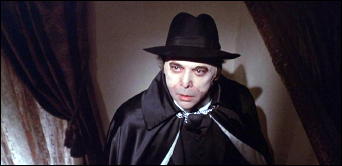
MURDERS IN THE RUE MORGUE. American International Pictures, 1971. Jason Robards, Herbert Lom, Christine Kaufmann, Adolfo Celi, Maria Perschy, Michael Dunn, Lilli Palmer. Screenwriters: Christopher Wicking & Henry Slesar, based on the story by Edgar Allan Poe. Director: Gordon Hessler.
When adapting what many critics consider to be the original modern detective story to film, there’s a temptation to do so in a manner that adheres too closely to the original text.

That’s definitely not a problem for Gordon Hessler’s Murders in the Rue Morgue, a film that’s so anarchic in spirit that it ends up little resembling Edgar Allan Poe’s locked door mystery. Borrowing as much from The Phantom of the Opera (1943) as from Poe’s tale, this uneven, but still enjoyable, American International production blends gothic horror, an early 1970s Paella Western aesthetic, and a sly commentary on the demarcations between the profession of acting and living in “real life.†The movie also benefits a rather unique score by the Argentine composer and conductor, Waldo de los RÃos.
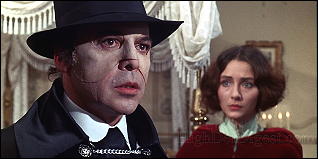
The plot revolves around an early twentieth-century Parisian theater troupe of the Grand Guignol variety. Led by the mercurial Cesar Charron (Jason Robards), the troupe includes a myriad of colorful members. In the midst of their theatrical run of a stage adaptation of Poe’s eponymous story, Charron finds that his cast and crew, both former and present, are being targeted for murder.
It’s only when the bodies start piling up that Charron begins to suspect that his former friend and rival, Rene Marot (Herbert Lom) is behind the horrific killings. Thing is: Marot is believed to be dead, having taken his own life after murdering Cesar’s wife’s, Madeline’s (Christine Kauffman) mother (Lilli Palmer) with an axe.

At the end of the day, however, it’s not the convoluted murder mystery plot that makes Murders in the Rue Morgue worth watching. Rather, the film is more an exercise in style and reflective of a certain type of Gothic horror cinema, one in which dreams, flashbacks, and hallucinatory sojourns play important roles in elucidating how the characters’ pasts and presents converge in tragic ways. The movie’s not a horror classic and doesn’t hold up very well when compared with Roger Corman’s Poe films, but it’s the product of a certain type of daring that was a hallmark of 1970s commercial cinema.
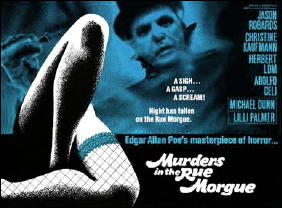
Tue 20 Sep 2016
DAN RAVEN “The High Cost of Living.” NBC, 20 September 1960; 60 minutes. Cast: Skip Homeier (Lt. Dan Raven), Dan Barton (Det. Sgt. Burke), Quinn K. Redeker. Guest Cast: Bobby Darin, Corey Allen, Richard Carlyle, Sue Ane Langdon. Director: Joseph M. Newman.
There is seriously conflicting information about this series online. Wikipedia says that the series began as a 30 minute program on January 23, 1960, and expanded to 60 minutes on September 23, whereas IMDb suggests that that was the date of the first program altogether. If the latter is correct, the episode I’ve just watched is Episode 1 of Season 1.
The setting of this fairly standard black and white police procedural is Los Angeles, and Hollywood’s famed Sunset Strip in particular. The extra gimmick, at least for this part of the run, is to have famous actors, actresses and other celebrities play themselves in leading roles in dramatized versions of scrapes they might get into. (From the preview provided at the end of this one, the next episode starred Buddy Hackett.)
Bobby Darin is framed for murder in this one, and it’s a fairly flimsy setup at that — his photo is found at the scene of the crime in a smashed frame (hmm) and a charred piece of notepaper is discovered in the fireplace with the name Bobby on it, paper from the club where he works.
I didn’t keep track, but Darin also gets to sing at least two songs. There’s also an old friend of his hanging around town would could provide an alibi for him, if he could only be found. I’m not sure the plotting is at all airtight, but I don’t imagine anyone at the time was going to ask for their money back if it wasn’t.
Skip Homeier had nearly a 40 year career in movies and TV, and while he never became a star, he did make a successful transition from child actor to at least a busy one as an adult. In this single episode of Dan Raven I’ve seen, he reminded me a bit of Lee Marvin, maybe better looking, but without the latter’s overwhelming onscreen charisma.
Mon 19 Sep 2016
CHARLES LEE SWEM – Werewolf. Doubleday Doran/Crime Club, hardcover, 1928.
Invited to Thistlewood, former sanitarium in New Jersey and now home to what is left of the Thistlestanc family and its odd retinue, David Lee hears the howl of a wolf and witnesses the fear of his former college roommate, Dick Thistlestane. As his visit ends, Dick asks Lee to look after his teenage sister, Jane, if anything should happen to him.
Something does happen: Dick is ostensibly killed by his German shepherd. Convinced that the dog would not have attacked his master, Lee returns to protect the girl and discovers the family curse. Roughly, for the curse is a complex one, fifty years earlier the mother of a young man accused of being a werewolf and executed told the Thistlestanes that the real werewolf would come and kill the members of the family.
Thistlestanes died then — and have died since — strangled by teethmarks. (Well, that’s what the book says; don’t blame me if it doesn’t make sense.)
The author of this only mystery, for which fact we can all be grateful, was secretary to Woodrow Wilson for many years. Since Wilson enjoyed mysteries, Swem chose to write one. It’s tolerably written, to be overly kind, but the denouement is nonsense that also possesses gaping holes. Knowing what I know about Wilson, I suspect he would have found it engrossing.
Mon 19 Sep 2016
TIMOTHY HALLINAN – Incinerator. Simeon Grist #4. William Morrow, hardcover, 1992. Avon, paperback, 1993.
I think I like Hallinan’s books a little more with each one. A couple more and he’ll move into my personal top ten.
Someone is dowsing LA’s derelicts with gasoline and incinerating them. Grist is hired by the wealthy daughter of the latest victim to find the killer, and then blindsided by a press release she issues. He very nearly quits the case the next day, after receiving a personal, hand-delivered note from the killer at his home. He is persuaded by the client and the police to continue; the police, who the client believes have done little until now to solve the case, think that Grist may furnish the only link to the killer that offers hope.
Reluctantly, he acquiesces, and enters into a shaky “partnership” with the LAPD and their psychiatrist; enforced by the client’s threat to go public with the whole mess if the police fail to cooperate.
The story sustains an unusual amount of tension as Grist and his unwilling and less than dependable allies try to identify the killer before he incinerates others, Grist included. If a spur were needed, it becomes apparent that the killer knows Grist personally. Grist wishes it were reciprocal.
The overeducated Simeon Grist — four degrees from UCLA — is one of the better-delineated and least clone-like PI’s of recent years. The killer is believable, and scary. Hallinan is an excellent writer, with a smooth narrative flow and good ear for dialogue. I think this is one of the better private detective tales of 1992.
The Simeon Grist series —
1. The Four Last Things (1989)
2. Everything but the Squeal (1990)
3. Skin Deep (1991)
4. Incinerator (1992)
5. The Man with No Time (1993)
6. The Bone Polisher (1995)
In more recent years, Hallinan has written seven adventures of Poke Rafferty, an American expatriate living in Bangkok, and six cases for Junior Bender, an ex-burglar turned PI for LA mobsters.
Sun 18 Sep 2016
ISIS. “The Lights of Mystery Mountain.” CBS, Season 1, Episode 1. 6 September 1975. The series was known as The Secrets of Isis in syndication. Cast: JoAnna Cameron (Andrea Thomas/Isis), Brian Cutler (Rick Mason), Joanna Pang (Cindy Lee). Guest Cast: Kelly Thordsen, Hank Brandt, Ken Wolger, Mike Maitland. Developed by Marc Richards. Director: Hollingsworth Morse.
Opening narration: “… a young science teacher dug up this lost treasure and found that she was heir to the secrets of Isis. And so, unknown even to her closest friends, Rick Mason and Cindy Lee, she became a dual person: Andrea Thomas, teacher; and Isis, dedicated foe of evil, defender of the weak, champion of truth and justice!”
According to Wikipedia, this Saturday morning TV series has the distinction of being “the first weekly, American, live-action television series with a female superhero lead character.” Although intended for kids, rumor has it that quite a few adults watched it, too. The star, Joanna Cameron was a former model with nice legs and as Isis, wore a very short white miniskirt. That may have had something to do with it.
In this first episode, Cindy Lee has taken photos up in the mountains of what appear to be UFOs, and she, Andrea and Rick decide to investigate further. Upon arrival they discover that several people have disappeared, leaving only circles of scorched earth behind them.
The story is paper thin, the special effects are minimal, and the action level is even less. Being a kids’ program, there’s a lesson to be learned by the two teen-aged boys who have helped the person behind this small semi-sinister plot. It’s all in good fun, and I’m sure anyone who watched this series back then still remembers it today.
Sat 17 Sep 2016
MARC DAVIS – Dirty Money. Dell, paperback original; 1st printing, February 1992.
This is the author’s only work of crime fiction, a one-shot private eye novel taking place in Chicago. The PI in question is a fellow named Frank Wolf, and since by profession Marc Davis was a commodities broker with that city’s Board of Trade, it’s not surprising that most of the underlying plot has to do with the selling of wheat, soybeans, silver, mortgages and the like.
Although hardly a broker himself, Wolf does have a serious gambling problem, the consequences of which form part of the underlying story line. The dead man was a broker, though, someone Wolf had known since grade school — one of the high-living people who can’t resist the thrill of taking risks. It’s just that he was a success at it– until, that is, he did someone enough wrong as to do him in.
This is one of those stories in which the lowly PI falls in love with the dead man’s daughter, the consequences of which also forms part of the underlying story line. This is also one of those stories which are overwritten, in my opinion, in both the opening and closing chapters. It’s the middle section that flows the easiest, in more or less standard PI style, this making this a book worth picking up, should you ever find yourself face to face with a copy, out there somewhere in the wild, as recently happened to me.